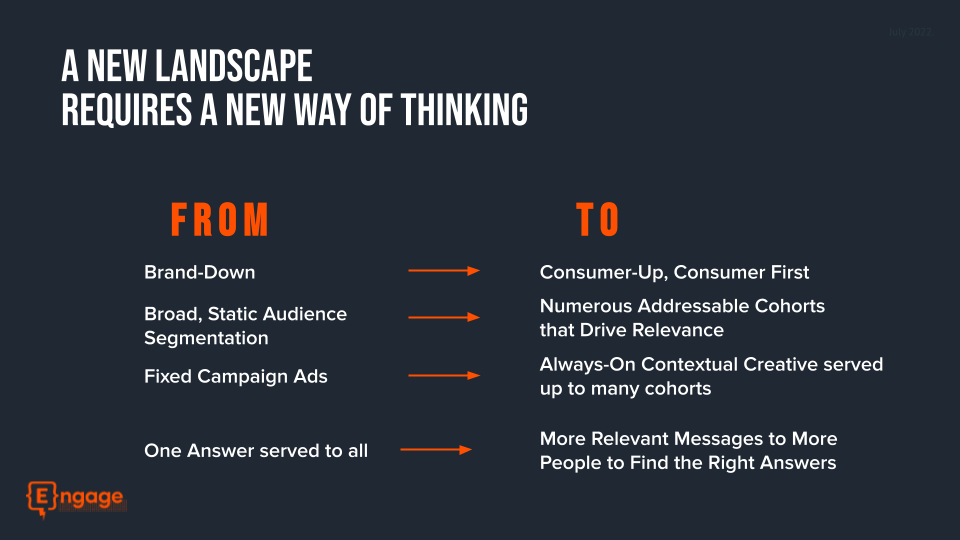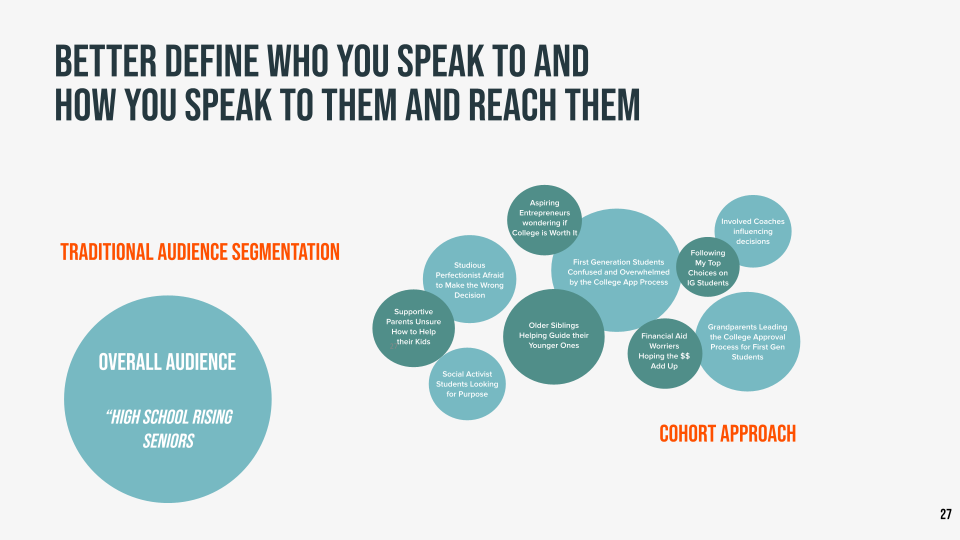How to Create Relevant Content With Student Cohorts
by Sirley Carballo · Updated Sep 22, 2022
The most successful brands have embraced the back-and-forth relationship between their customers and their products, particularly for today’s non-traditional and Gen-Z audiences. Why hasn’t higher ed?
The higher ed “market” is not a monolith and we need to stop marketing to a homogeneous segment of students defined in broad, general strokes.
When we recognize the differences (demographic, psychographic, regional, background, mindsets) within our incredibly diverse world, we can rethink the ways in which we create personalized content for student cohorts.
Wanda Pogue, Chief Strategy Officer at VaynerMedia joined us for this year’s Engage Summit 2022 where she spoke all about the power of personalized cohorts and how institutions can use them to drive relevance with today’s students.

Marketing, past, present and future is about people, always has been and always will be. It is one of the most human professions in the world.

An Inevitable Evolution—Relevance over Reach
The world of advertising used to be focused on casting a wide net and trying to reach as many people as possible with one key message. The goals were simple: establish a need and draw awareness to that brand.
This might have worked when there were fewer options but as we’ve seen in the past couple of years, it’s not sustainable for higher ed to solely target one group of people (rising seniors) with one simple message (get a 4-year degree at our school) and expect to reach recruitment goals year over year.
Today’s landscape is different. Just as the diversity in products and consumer preferences has become more prolific, so too has the world of higher education and the students it serves. With certificate programs, technical degrees, online and hybrid options, and more, today’s students have more choices than ever.

Putting Students in the Driver’s Seat
Universities can no longer solely rely on brand awareness. Instead, schools must drive preference and consideration by truly connecting with their audience to understand their needs and learn what drives their decision-making.
What’s more, is they need to be where students are. Studies show that today’s 16-24-year-olds spend an average of 3 hours on social media a day, and they’re not alone. Adults are right behind, spending 2.5 hours of their days on social media.
So what does this mean? If schools want to reach today’s students, it has to be on their preferred device, where they spend time, and in a way that feels made just for them.
Driving Relevance via Cohorts
Today’s students are vast and ever-evolving. Think about the student body at your colleges. Students are diverse in:
- Age
- Race
- Thought
- Experience
- Preference
- A multitude of other categories
Our marketing approach should be just as fluid and multi-dimensional.
One of the biggest opportunities to achieve this shift is for schools to rethink traditional segmentation models and instead identify a wide range of consumer “cohorts” that might exist for their institutions.
Using Cohorts to Build Relevance and Affinity
By looking at the audience via a cohort approach, schools are able to understand that different students engage with them for a variety of reasons, and thus allowing them to produce creative content that is truly contextual and therefore more compelling.
For example, instead of fixed campaign ads, schools can shift to always-on contextual creative that’s served to many cohorts, not just one. Instead of one answer served to all potential students, schools can produce more relevant messages to more people to find the right answers.
Beyond the increased potential of connecting with students in a way that cuts through the noise, cohorts are extremely valuable because they:
- Allow for greater creative receptivity
- Drive media effectiveness
- Enable more relevant strategic choices
- Deliver long-term brand and business goals
- Let us uncover more meaningful insights

Student Segments vs Cohorts
Cohorts are defined as nuanced and unique addressable groups of current and potential consumers/customers, thoughtfully identified and designed to maximize relevance for the brand. The better we can define the many various cohorts for each brand, the better we can understand, create, target, design, and have meaningful and consistent dialogue with them.
This means going beyond seeing rising seniors, for example, as one group, and instead and identifying unique cohorts that exist within that one group.
If you’re thinking “oh, we do that already with segments,” we encourage you to go deeper.
A segment is formed by broad groups of people, often mutually exclusive such as a rising high school senior or their parents. A cohort is nuanced and specific based on a range of inputs that are not mutually exclusive such as a first-generation Latino student in California navigating higher ed for the first time.
Moving from the traditional audience segmentation to a cohort approach might look like this:
- Social activist students looking for purpose
- Supportive parents unsure of how to help their kids
- Studious perfectionists afraid of making the wrong decision
- Aspiring entrepreneurs wondering if college is worth it
- Involved coaches heavily influencing student decisions
- Financial aid worriers wondering if the money will add up
- Students following top college choices on Instagram
This deeper level of understanding brings a layer of humanity and empathy that allows us to deliver tailored messages that speak directly and authentically to specific groups. The cookie-cutter viewbooks and flyers or the mass emails just won’t cut it anymore. In order to enable stronger innovation, utility, and impact, we need to get specific and personalized.
By truly understanding the diversity of the consumers we serve, we can actually increase the relevance and affinity of our brands and cut through the noise to truly reach today’s students.
To learn more about student-centered engagement, book your personalized demo of Element451 here.

About Element451
Boost enrollment, improve engagement, and support students with an AI workforce built for higher ed. Element451 makes personalization scalable and success repeatable.
Categories
New Blog Posts

The Definitive Guide
AI in Higher Education
Bridge the gap between the latest tech advancements and your institution's success.
Useful Links
Related Articles

Talk With Us
Element451 is the only AI Workforce Platform for higher education. Our friendly experts are here to help you explore how Element451 can improve outcomes for your school.
Get a Demo








